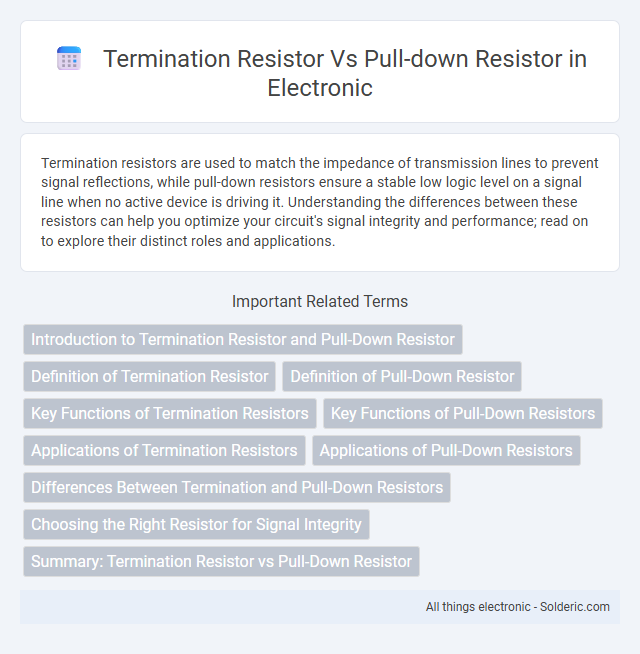Termination resistors are used to match the impedance of transmission lines to prevent signal reflections, while pull-down resistors ensure a stable low logic level on a signal line when no active device is driving it. Understanding the differences between these resistors can help you optimize your circuit's signal integrity and performance; read on to explore their distinct roles and applications.
Comparison Table
| Feature | Termination Resistor | Pull-Down Resistor |
|---|---|---|
| Purpose | Prevents signal reflections on transmission lines | Ensures a known LOW logic level when no input is present |
| Typical Value | 50 O to 120 O (matching line impedance) | 10 kO to 100 kO |
| Location | Placed at the end of high-speed data lines or buses | Connected between input pin and ground |
| Function | Absorbs signal energy to reduce reflections and noise | Pulls input voltage down to ground to avoid floating state |
| Application | High-speed digital communication, transmission lines | Digital input pins, switches, buttons |
| Impact on Signal | Improves signal integrity by impedance matching | Prevents undefined or floating input states |
Introduction to Termination Resistor and Pull-Down Resistor
Termination resistors are used primarily to prevent signal reflections in high-speed digital circuits by matching the impedance of transmission lines. Pull-down resistors ensure a defined logic level by connecting a signal line to ground when no active device is driving it, preventing floating inputs. Understanding the distinct roles of termination and pull-down resistors helps optimize signal integrity and avoid erratic behavior in your electronics designs.
Definition of Termination Resistor
A termination resistor is a precisely valued resistor placed at the end of a transmission line to match the line's characteristic impedance, minimizing signal reflections and ensuring signal integrity. Unlike a pull-down resistor, which connects a circuit node to ground to define a logic state, the termination resistor's primary role is to prevent signal distortion in high-frequency or high-speed digital circuits. Proper use of termination resistors helps your electronic design maintain clean signal transmission and reduces electromagnetic interference.
Definition of Pull-Down Resistor
A pull-down resistor is a resistor connected between a signal line and ground to ensure the line reads a defined low logic level when no active device is driving it. This prevents floating inputs, which can cause unpredictable behavior in digital circuits. Unlike termination resistors, which match impedance to reduce signal reflections, pull-down resistors stabilize input signals by maintaining a default voltage level.
Key Functions of Termination Resistors
Termination resistors primarily prevent signal reflections by matching the impedance of transmission lines, ensuring signal integrity in high-speed digital circuits. They absorb the energy of transmitted signals at the end of a bus or line, reducing noise and distortion that can affect data accuracy. Your circuit's performance improves significantly when termination resistors are correctly implemented to maintain proper signal levels and timing.
Key Functions of Pull-Down Resistors
Pull-down resistors ensure a defined low logic level by connecting the input pin directly to ground, preventing floating inputs and erratic behavior in digital circuits. These resistors stabilize the signal by pulling the voltage to zero when no active signal is present, which helps maintain consistent performance. Your circuit benefits from improved noise immunity and reliable input readings due to the key function of pull-down resistors.
Applications of Termination Resistors
Termination resistors are primarily used in high-speed digital communication lines to prevent signal reflections and ensure data integrity by matching the impedance of the transmission line. They are commonly applied in differential signaling protocols such as CAN bus, Ethernet, and RS-485 to maintain signal quality over long cable runs. By minimizing signal distortion and electromagnetic interference, termination resistors enhance the reliability and performance of high-frequency data transmission systems.
Applications of Pull-Down Resistors
Pull-down resistors are primarily used in digital circuits to ensure input pins default to a low logic level when no active signal is present, preventing floating states and erratic behavior. They stabilize switch inputs, microcontroller pins, and logic gates by providing a defined ground reference. Unlike termination resistors that minimize signal reflections in high-speed data lines, pull-down resistors maintain signal integrity in low-frequency input detection and noise reduction.
Differences Between Termination and Pull-Down Resistors
Termination resistors are used to match the impedance of a transmission line to prevent signal reflections and maintain signal integrity in high-speed digital circuits. Pull-down resistors, in contrast, ensure that a signal line defaults to a low logic level when no active drive is present, preventing floating inputs. While termination resistors typically match characteristic line impedance (e.g., 50 or 75 ohms), pull-down resistors usually have higher resistance values (e.g., 10k ohms) to minimize current draw.
Choosing the Right Resistor for Signal Integrity
Choosing the right resistor for signal integrity depends on the specific application: termination resistors, typically matching the characteristic impedance of transmission lines (commonly 50-100 ohms), are essential to minimize signal reflections and maintain waveform integrity in high-speed digital signals. Pull-down resistors, usually ranging from 10k to 100k ohms, serve to define default logic levels and prevent floating inputs but do not address impedance matching or signal reflections. Selecting termination resistors ensures optimal signal quality in high-frequency circuits, whereas pull-down resistors primarily control logic states and prevent noise-induced errors.
Summary: Termination Resistor vs Pull-Down Resistor
Termination resistors are used to match impedance and minimize signal reflections in high-speed transmission lines, ensuring signal integrity. Pull-down resistors provide a defined logic level by connecting a signal line to ground when no active device is driving the line, preventing floating states. While termination resistors optimize signal quality in communication circuits, pull-down resistors ensure stable digital input states in logic circuits.
termination resistor vs pull-down resistor Infographic

 solderic.com
solderic.com